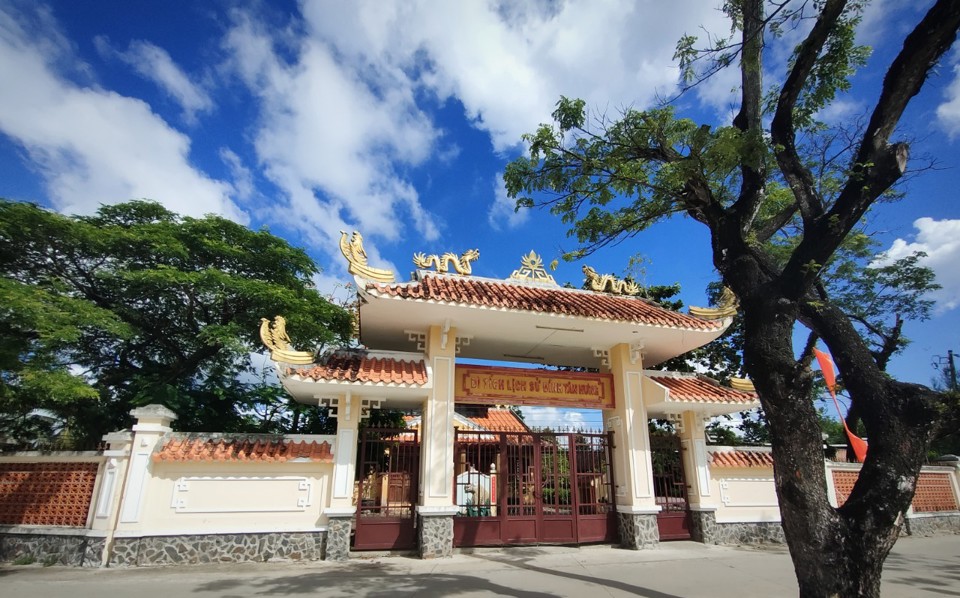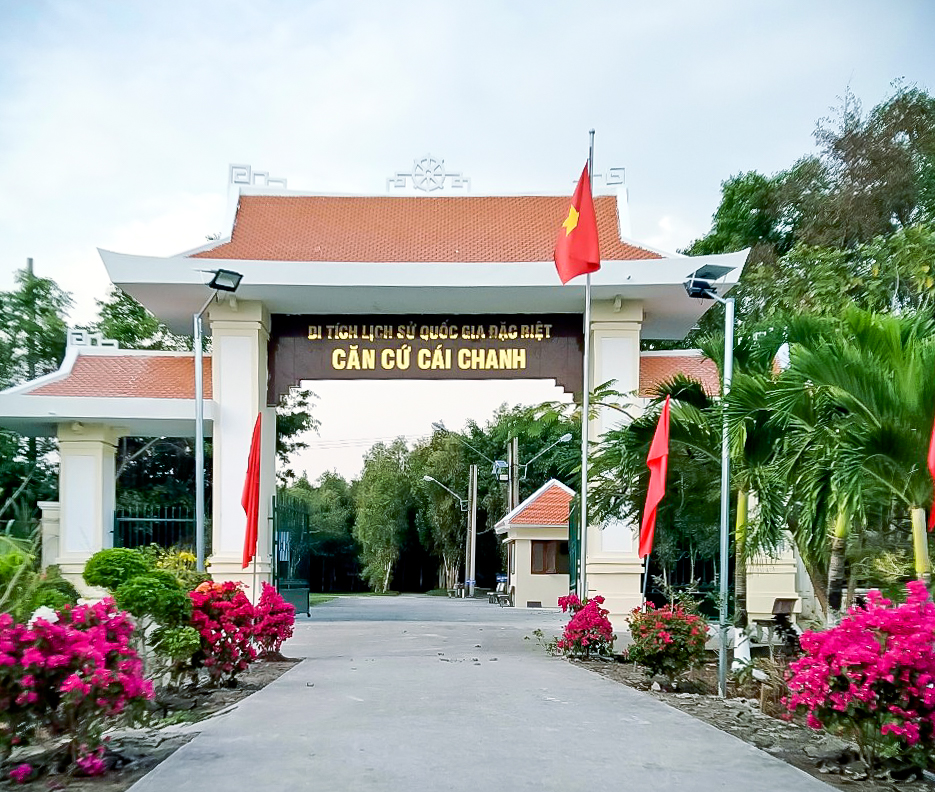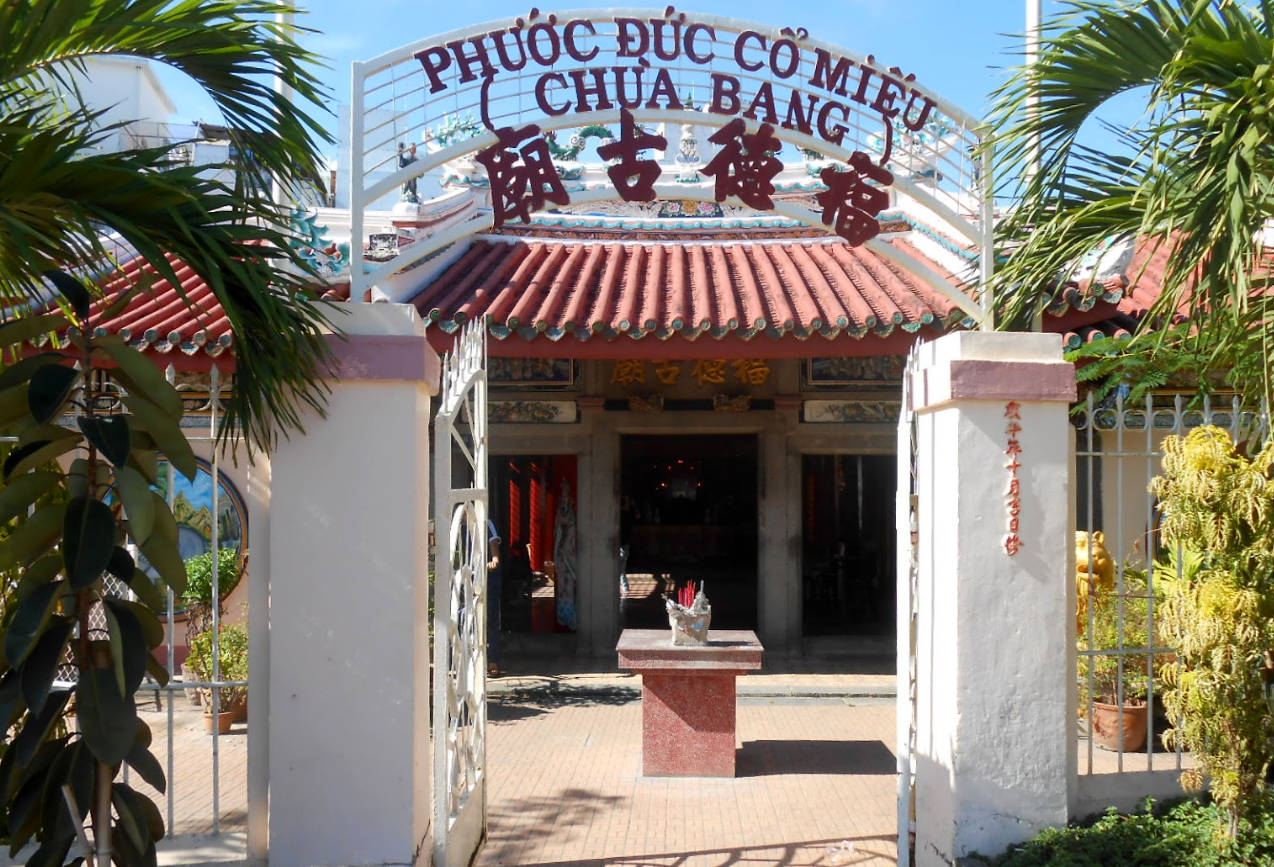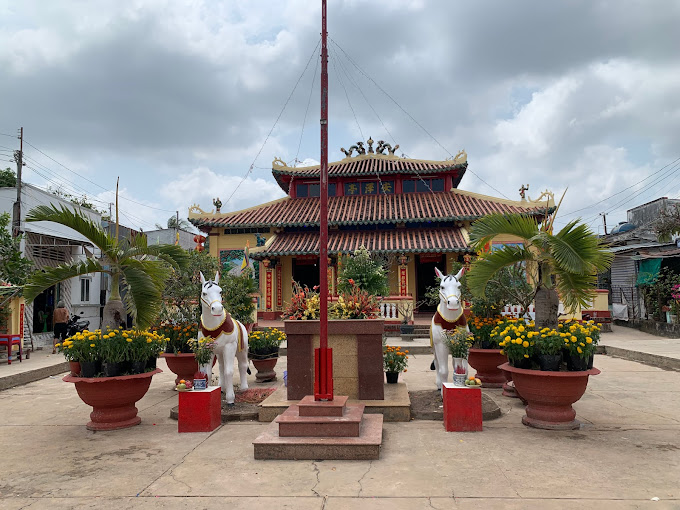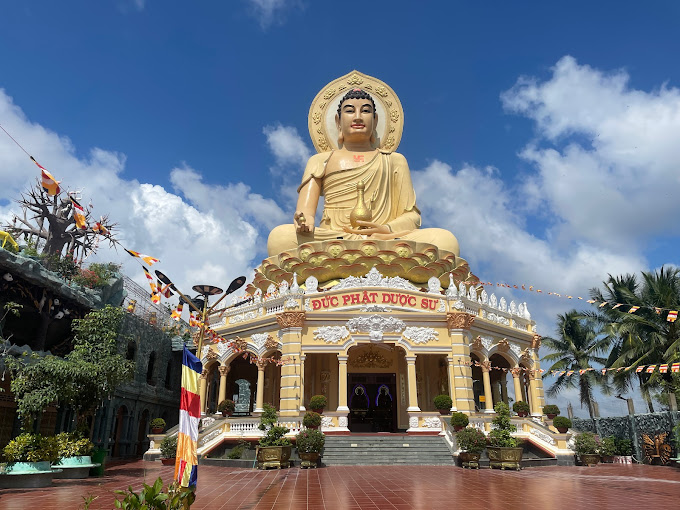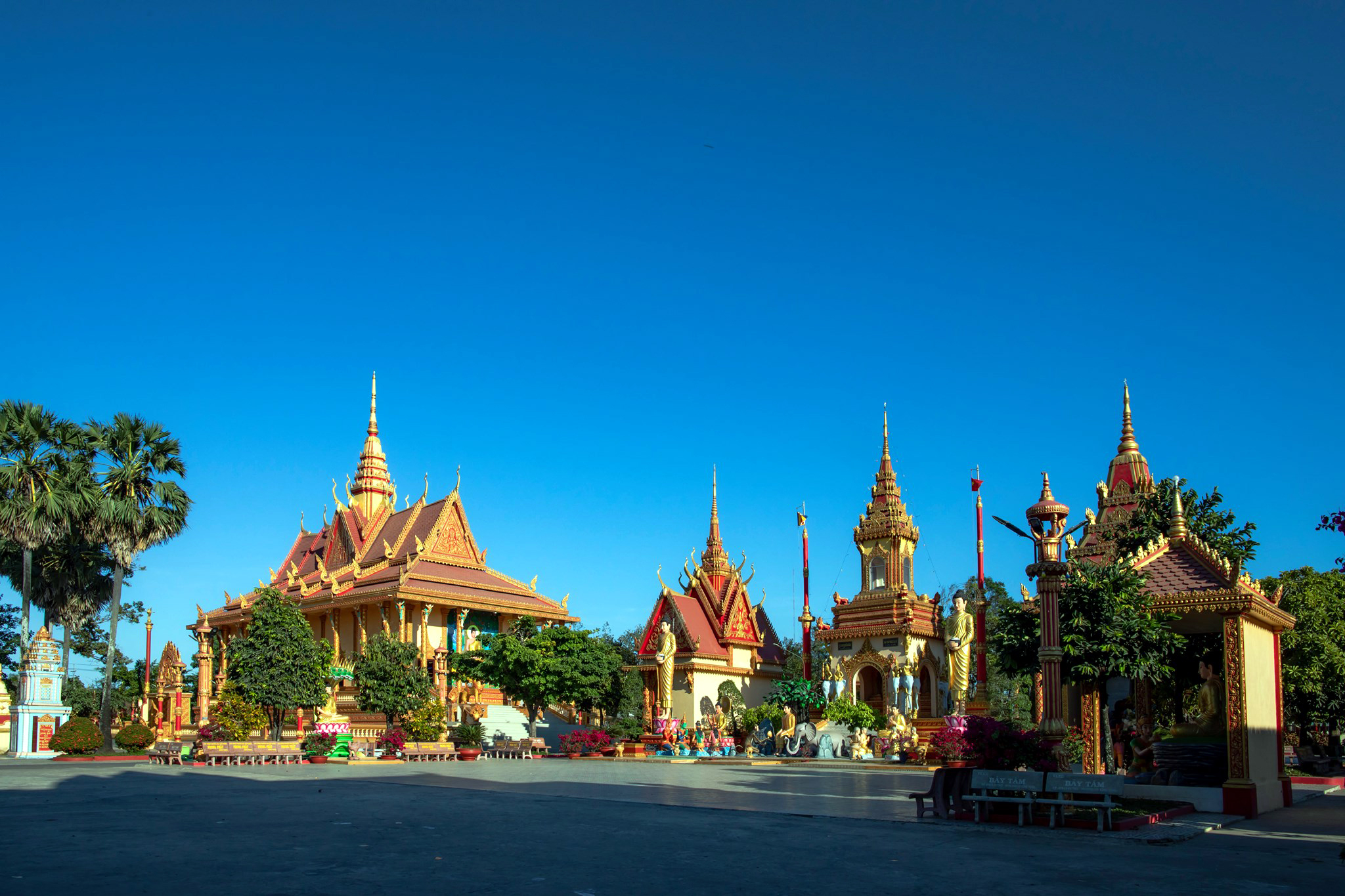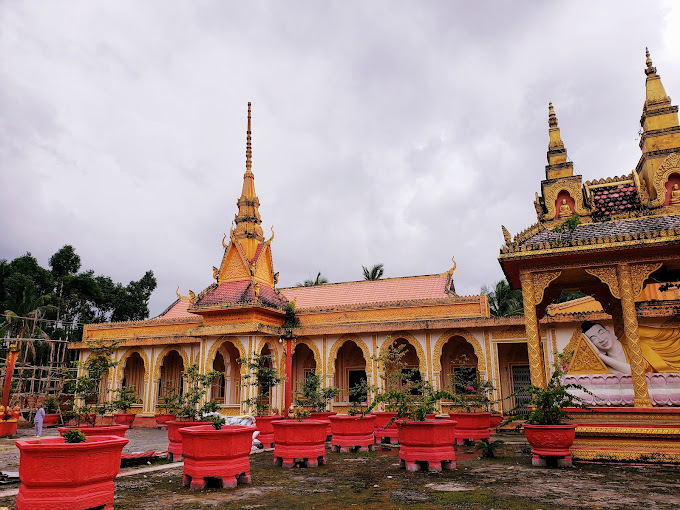Relic point Vietnam
Việt NamTan Hung Communal House
Tan Hung Communal House was the first place to hang the flag of the Indochinese Communist Party in Ca Mau (in 1930) and was also the headquarters of the Tan Hung Front Command, the anti-French front in Ca Mau. Tan Hung communal house is located in Tan Hung hamlet, Ly Van Lam commune, Ca Mau city. Tan Hung Communal House is an ancient communal house worshiping the God Hoang Bon Canh, built by people in 1907. However, due to time and war, the communal house was completely destroyed. On the old ground, local people built another smaller communal house. In 2014, Tan Hung communal house relic was upgraded and restored including many items and works. The main communal house consists of one room and two wings, the roof is covered with yin and yang tiles, and on the roof are cast two flanking dragons. In front of the communal house is a tiger-shaped brick screen, on both sides there are two square brick pillars, the top of the pillars is covered with two stone lotus flowers. On both sides of the yard there are two small temples worshiping the God of Agriculture and the God of Earth. The main altar space of the communal house worshiping the God Hoang Bon Canh is majestically arranged with pedestals displaying swords, spears, drums, images of dragons and cranes. Tan Hung Communal House also has a space to worship Uncle Ho's image, placed in a solemn position. Tan Hung communal house was once awarded the title Bon Canh Thanh Hoang by King Tu Duc in the 5th year of Tu Duc (1852). Elders in the area said that on King Tu Duc's regalia were written the eight words "Righteousness - Huu gentleness - Don stop - Chi Than". The sacred spirit has now been lost due to the chaos of war. In the temple, there is still a sacred spirit container engraved with a winding dragon image. Every year, on the 10th and 11th days of the 5th lunar month, people in the region and tourists from everywhere come here to attend the Ky Yen ceremony at Tan Hung communal house. In addition to its spiritual meaning, paying respect to the gods and protecting tutelary gods, Ky Yen ceremony also aims to commemorate those who have contributed to the country and have fallen on this land. Tan Hung communal house has great cultural and historical value. At the same time, it is an image of preserving and promoting the cultural identity of Ca Mau province, the southernmost region of the country. For many generations, for local people, the communal house is the place where they entrust their dreams and aspirations for a peaceful, prosperous and happy life. Not only is it a place for cultural and religious activities of the people in the region, Tan Hung communal house is also a famous communal house in the history of struggle of the people of Ca Mau. Tan Hung Communal House is the first place in the province where the event of hanging the flag of the Indochina Communist Party (predecessor of the Communist Party of Vietnam) took place on the top of the poplar tree in front of the communal house. The red hammer and sickle flag has the words: "Eliminate the Dharma bandits". For the first time, the people of Ca Mau saw the Party flag publicly appear. And also here, on March 1, 1946, the Tan Hung Front was established. With the meaning of marking many historical revolutionary events, on August 4, 1992, Tan Hung communal house was ranked as a National Historical - Cultural Monument, becoming a "red address" for the young generation to learn about. , learning about historical values, culture, and traditions of fighting to protect the country that our ancestors left behind. Source: Ca Mau Tourism
Ca Mau 4116 view
Hon Da Bac relic site
Hon Da Bac is about 500 meters from the mainland, has an area of 6.34 hectares, located in the west of Ca Mau Peninsula, in Kinh Hon hamlet, Khanh Binh Tay commune, Tran Van Thoi district, Ca Mau province. Silver Rock includes Ong Ngo Rock, Silver Rock, and Odd Silver Rock. The highest peak of the island is about 50 meters above sea level. Although not a large island, Hon Da Bac is very convenient for all types of marine vehicles to anchor and avoid storms. Along with Hon Khoai, Hon Chuoi, Hon Da Bac is one of the island clusters with a strategic economic - defense - security position in the sea - Ca Mau island. Looking on the map, Hon Da Bac looks like a forward station guarding the air and sea southwest of Cape Ca Mau. Silver Rock - as its name suggests - around the island, on the water surface, and on the seabed, thousands of granite stones of all sizes lie on top of each other, forming many shapes as if arranged by humans. Walking on Hon Da Bac, visitors encounter Fairy hands, Fairy footprints, Fairy wells, and tiger feet. On the eastern peak of Hon Da Bac, there are large rocks and a fairly wide surface. Between the two pieces of rock there is a deep hole shaped like a foot. Legend has it that that footprint is the Fairy's foot, and this piece of rock is the Fairy's yard. On the island there are a few small temples such as Hang Pagoda and Tinh Do Pagoda. In particular, on the highest peak of Hon Da Bac is Ong Nam Hai temple - a place to worship the 13m long Ong fish skeleton. On May 20, 1995, Ong fish drifted into the Ong Doc river mouth area. About 3 days later, Ong Giat (died), Song Doc fishermen buried him and in 1996 brought the skeleton to Hon Da Bac to worship. Whenever fishermen in this area encounter big waves or strong winds when going to sea, they are saved by Ong fish. Therefore, the fishermen here silently thanked him and worshiped him as a god who saved humanity. Legend has it that Ong Nam Hai temple is very sacred. Today, not only fishermen in the area but also tourists from everywhere who hear his sacred voice come to pay their respects and pray for him to bless his family with peace, without encountering troubles or troubles. During the years of resistance against the US to save the country, the enemy chose Hon Da Bac as the place to station the 105 mm artillery platoon to control the Khanh Binh Tay revolutionary base area and the western coastal line of Ca Mau. This is also the location where the CM12 project took place, defeating the plot to import, sabotage, and overthrow the socialist regime in our country by the reactionary organization "Vietnam Restoration" led by Le Quoc Tuy and Mai Van Hanh. head. On June 22, 2009, the Ministry of Culture, Sports and Tourism recognized the relic: Hon Da Bac - CM12 Counterintelligence Plan Command Center (September 9, 1981 - September 9, 1984) as a Monument. national history and culture. The Ministry of Public Security and Ca Mau province built the CM12 Victory Monument, Traditional House, and Uncle Ho temple at this famous relic. Source: Ca Mau Province Electronic Information Portal
Ca Mau 5068 view
Cai Chanh Base Special National Monument
Cai Chanh Base (another name is Bac Lieu Provincial Party Committee Base Area), located in small Cai Chanh hamlet, Cay Cui hamlet, Ninh Thanh Loi commune, Hong Dan district, Bac Lieu province. Cai Chanh Base is the place of residence and operations of the Southern Regional Party Committee, the Central Committee of the Southern Department, and the Southern Administrative Resistance Committee: During the resistance war against the French colonialists, in the period from 1949 - 1954, the Base Cai Chanh base is the place of residence and revolutionary activities of the leaders of the Southern Party Committee, the Central Committee of the Southern Department, and the Southern Administrative Resistance Committee. The base is where many senior leaders of the Party and State operate. During the resistance war, at Dong Thap Muoi Base area as well as Cai Chanh, U Minh Bases and many other locations in the Southwest region, agencies and officers of the Southern Regional Party Committee and the Central Committee of the Southern Department , the Southern Administrative Resistance Committee is generally protected and safe, the people are truly the Party's "hundred hands and thousand eyes", firmly protecting the Party from victory to victory. Cai Chanh is where the Bac Lieu Provincial Party Committee Base was located during the resistance war against the US, period from 1973 - 1975: During the resistance war against the US to save the country, Cai Chanh area, Ninh Thanh commune once again became a revolutionary base. solid network. This was the base for revolutionary activities of the Bac Lieu Provincial Party Committee in the period 1973 - 1975. Also at this base, on January 13, 1975, the Provincial Party Committee met and approved the determination to liberate Bac Lieu province; At the same time, decided to move the Provincial Party Committee Base from Cai Chanh (Ninh Thanh Loi commune) to Lai Viet (Ninh Quoi commune), Hong Dan district to facilitate directing the attack point to liberate Bac Lieu town. By April 30, 1975, Bac Lieu province was liberated. Cai Chanh Base, from the time it was established by the Provincial Party Committee (November 1973) until the Provincial Party Committee moved it to Lai Viet (January 1975), has fulfilled its historical mission well, being a place to hide, shelter and protect. entirely for the Provincial Party Committee to lead the revolution to victory. Cai Chanh base is the place to recreate the revolutionary activities of leaders, agencies and people in both periods of resistance against the French and the Americans. During the resistance war against the French, Cai Chanh Base was the stationing and operating location of the Southern Regional Party Committee, Central Bureau of the South, Southern Administrative Resistance Committee, period 1949 - 1952. Here, the people sheltered, protected, and nurtured many high-ranking leaders of the Party and State. During the resistance war, at Dong Thap Muoi Base area as well as Cai Chanh, U Minh Bases and many other locations in the Southwest region, agencies and officers of the Southern Regional Party Committee and the Central Committee of the Southern Department , the Southern Administrative Resistance Committee are all protected and safe, the people are truly the Party's "hundred hands and thousand eyes", firmly protecting the Party from victory to victory. Cai Chanh base includes the main architectural items: Gate, exhibition house, stele house, comrade Le Duan's living and working house, conference hall, Provincial Party Committee Secretary's house, and the agency's kitchen. Provincial Party Committee, clerical and medical house, cipher house, radio house, defense platoon house, Provincial Party Committee Chief's office house, base construction committee house, waiting house, bunkers... With the above typical values, Cai Chanh Base was ranked by the Prime Minister as a special national historical site on December 31, 2020. Source: Department of Cultural Heritage
Ca Mau 4303 view
Phuoc Duc Ancient Temple
Phuoc Duc Ancient Temple, also known as Bang Pagoda, is located at 74 Dien Bien Phu Street, Ward 3, Bac Lieu City. This is the oldest temple of the Chinese people living in Bac Lieu. Phuoc Duc ancient temple was built by a group of Chinese people around 1810. Initially, the temple was built with simple leaves to worship gods according to Chinese folk beliefs such as: Bon Dau Cong (Ong Bon), Quan Di, Than Nong, Earth Duke, Mr. and Mrs. Cong Mau. Because Ong Bon is the main worshiper, it is called "Ong Bon temple"; Later, it was changed to "Phuoc Duc ancient temple", because the Chinese believe that Bon Dau Cong is also the main god Phuoc Duc - a god who is considered to be responsible for reclaiming land and supporting people to make a living and have a good career. peaceful life. In 1903, Chaozhou State was established, headquartered at Phuoc Duc ancient temple, in a large room next to Tay Lang, so it is also called Bang Pagoda. From a small temple with a modest area, after many restorations, the temple today has an area of 580 m2, following the Quoc-shaped architecture, a royal architecture style of the Ming Dynasty, China. The entire temple is a large-scale and flawless architectural work of art exuding majestic and ancient beauty. Columns, rafter ends, slanted ends, crowns, and altars made of stone and precious wood are all meticulously, elaborately, and exquisitely carved with gold-plated Chinese characters, following the style of the Book of Action and the Book of Revelation. All represent the following themes: Four sacred animals (dragon, unicorn, tortoise, phoenix), plants, flowers, dolls and magical beasts. In addition, there are decorated horizontal panels and couplets that are painted in vermilion and splendidly gilded. On the roof of the temple, there is a pair of dragons flanking the sun (two dragons in the sun), the most common image decorated on Chinese temples, symbolizing eternal happiness. The roof is covered with tube tiles, the roof border is made of green glazed ceramic, the end of the roof is decorated with a dragon-shaped pattern, on both sides are two small ceramic statues symbolizing yin and yang, the source of all harmony and discipline of all things. . Each part of the temple is considered an antique with high artistic value. With durable materials, Phuoc Duc ancient temple exists solidly to this day. These works of art have been harmoniously and closely linked together by artisans to form a unique architectural whole. Not only is it a place to worship the gods, Phuoc Duc ancient temple is also the base for revolutionary activities of Long Thanh village cell, Vinh Loi district, Bac Lieu province with comrade Nguyen Van Dang as secretary from 1930 to 1954. With With those values, the pagoda was recognized by the Ministry of Culture and Information as a national historical and cultural relic in 2000. Every year at Phuoc Duc ancient temple, major festivals are held such as: Via Ong Bon; Vu Lan Ceremony; Ky Yen Festival... The biggest is the Via Ong Bon festival held on the 29th day of the third lunar month; and Vu Lan festival is held on the full moon day of the 7th lunar month. Phuoc Duc ancient temple is not only a spiritual place for local people but also becomes a beauty of the cultural identity of the Chinese people in Bac Lieu. Source: Bac Lieu Tourism
Ca Mau 3722 view
Thanh Hoang Ancient Temple
Recognized by the Ministry of Culture, Sports and Tourism as a national historical and cultural relic in 2001, the Imperial City Ancient Temple (also known as Vinh Trieu Minh Pagoda) is a relic expressing religious culture. The tutelary god of the Vietnamese people in Bac Lieu, a cultural feature that inherits the tutelary god belief of the Chinese people in Bac Lieu... Vinh Trieu Minh Pagoda is located on Dien Bien Phu Street in Ward 3 (Bac Lieu City) and was built in the year At Suu 1865. This is a place to worship the ancestors who have openly explored and expanded this land many years ago. previous century. Although it is not a place to worship Buddha, people used to call it Vinh Huong Pagoda, founded by the Minh Huong people. Later, local people called it Minh Pagoda, and now the official name is Vinh Trieu Minh Ancient Temple. The origin of worshiping the tutelary god is also from the Minh Huong people, inheriting the tutelary god belief in China. According to customs here, the time to organize the annual Imperial Wedding Ceremony usually lasts for 3 days and nights (24, 25 and 26 of the 7th lunar month) with rituals such as: worshiping, worshiping ghosts and distributing rice. … The pagoda faces the Bac Lieu River, the main door to the pagoda is assembled from green stone pillars meticulously and delicately carved with images of dragons, cranes, clouds... The entire pagoda architecture is built in the shape of the word "National". ”, a model of royal architecture of the Ming Dynasty (China). The porch is covered with three-layer yin-yang tiles, the roof corners are decorated with curving wave patterns. In addition, in the pagoda there are also carved patterns such as animals, ornamental plants, leaves and fairies... In front of the altar to worship the Tutelary God is a long table made of precious wood, in the middle of the table is a bronze urn about 70 cm high. , this is a rare type of bamboo urn in Vietnam... The ancient tutelary god Vinh Trieu Minh temple is a priceless heritage that represents a unique cultural and religious belief of the Chinese people in Bac Lieu. Source: Bac Lieu Newspaper online
Ca Mau 5060 view
An Trach Communal House
An Trach communal house is located in An Trach hamlet, Vinh Loi commune, Thanh Hoa district (now in group 2, ward 5, Bac Lieu town - Bac Lieu province). The communal house was built by Tri Pham Thanh Mau district on April 6, 1877 (year of Dinh Suu) on a land area of 4,000 square meters and personally served as the chief worshiper; Tri Ho Van Thanh district made offerings. Because construction conditions at that time were still limited, An Trach communal house simply looked like a three-compartment roof, and the materials used were also very primitive. Later, through many stages, the communal house was built larger, more solid and majestic with multilateral and multi-directional architecture following Hue communal house architecture. The architectural works of the communal house include: The main communal house, the front communal house yard, the rear communal house yard, the rear communal house, four corners with small shrines, two rows of houses Dong Lang and Tay Lang. The main communal house has a 0.75m high foundation, 4 porches, 8 roofs, and the top of the roof has "Four dragons painting pearls". The communal house's porch has 4 roofs: the front, back, Dong Lang and Tay Lang are all covered with tubular tiles. The top of the flowing roof has blue ceramic tiles with jagged and patterned patterns. Each porch has 4 square load-bearing columns, built of card bricks and covered with moldings in the shape of a bowl. The front porch's four columns have a chrysanthemum leaf pattern painted in light green at the top, and a parallel sentence is written on each column. During the reign of King Khai Dinh (1916 - 1925), An Trach communal house was awarded the title "Bon Canh Thanh Hoang". According to folk legend, in the past, An Trach communal house worshiped the famous scholar Nguyen Cong Tru, a mandarin during the reign of King Tu Duc, who had a spirit of patriotism, love for the people, and openly restored and expanded the territory. Every year, on the 14th day of the 11th lunar month, the communal house holds his death anniversary. In the main holidays, such as: Ky Yen and Vu Lan, there are memorial services to Nguyen Cong Tru, praying for him to help the people, praying for good weather, peace and prosperity... That respect has entered the heart. The spirit of the local people is like a natural flow. This is also an expression of good morality from thousands of generations of our nation. During the years of resisting the French and expelling the Americans, the communal house was the place to organize revolutionary meetings and events, harbor communists... Recognizing its cultural and historical value, in 2000, An Trach communal house was recognized Recognized as a national historical, architectural and artistic relic. Currently, the People's Committee of Bac Lieu province is having an architectural project to restore the communal house to be more spacious and solid, in order to enhance the role and significance of the communal house in the spiritual life of the people, not only in the province. Source: Bac Lieu Tourism
Ca Mau 4577 view
Vinh Hung ancient tower
Vinh Hung ancient tower is located in Trung Hung 1B hamlet, Vinh Hung A commune, Vinh Loi district, Bac Lieu province. Not only is this the only tower architecture of the Oc - Eo culture left in the Southwest, but during the excavation at Vinh Hung tower, archaeologists also obtained many extremely valuable artifacts. with many statues of stone, bronze, ceramic, precious stones... marking a rather long period of existence and development (from the 4th century to the 13th century AD) of Vinh Hung ancient tower. Vinh Hung Tower has undergone many surveys. In 1911, French scholar Lunet de Lajonquiere discovered it under the name Tra Long Tower. In 1917 Henri Parmentier came to survey this area. In this report (under the name Luc Hien tower) he listed a number of artifacts discovered inside and outside the tower. In particular, among them is a stele found in Phuoc Buu Tu pagoda next to the tower engraved with Sanskrit characters, clearly stating the month Karhila, year 814, corresponding to 892 AD, and the name of King Yacovan-Man (20th century AD). 9th century). Archaeologists have determined that the tower was built around the 9th century AD to worship the Khmer king named Yacovar - Man. In May 1990, archaeologists from the Institute for Sustainable Development of the Southern Region in collaboration with the Minh Hai Provincial Museum came to survey and dig a survey hole, discovering a number of artifacts such as the heads of statues of gods and demons. literature, grinding table, Linga - Yoni... Continuing the journey to clarify the value of a national monument, as well as to serve the restoration, embellishment, and anti-degradation of Vinh Hung tower relics, in 2002 and then in 2011, The Archaeological Research Center coordinated with the Bac Lieu Provincial Museum to excavate around the tower. These excavations continue to do things such as revealing the base of the tower, solving traces buried in the ground to have solutions to restore and embellish the tower to promote the value of the monument. Many valuable artifacts have been discovered during surveys such as: the Goddess statue carved in the traditional style, the round Oc Eo Phu Nam statue, the right hand of the "God Statue", a number of Linga - Yoni, objects ceramics used in everyday life and especially the set of bronze statues are considered by archaeologists to be a unique collection of statues, a "national treasure", including a number of unique statues of very high value. In 2011, the Vinh Hung tower relic was restored and renovated, including the following items: exhibition house, stele house, guard house, fence and a number of other items to preserve and promote the value of the relic. The ancient tower has a quite simple and rustic architecture on a promontory of about 100m2, the Tower's door faces west, the base of the Tower is rectangular with two sides of 5.6m and 6.9m. The height of the Tower is 8.2m (calculated from the Tower's base). All three sides East - South - North are built of bricks. The wall at the base of the Tower is 1.8m thick. The higher you go, the thinner the wall becomes. The wall is gradually tilted towards the top, forming a rolling dome. According to many scientists, the ancient Khmer people used a special construction technique, they used a type of vegetable glue to stick bricks together, without using construction materials such as cement, or lime mortar like now. The tower was built with two types of bricks of different colors. From the base of the tower to a height of 4m are red bricks and from 4m upwards are white bricks. Looking in from the main door is the restored Linga - Yoni set symbolizing yin and yang harmony. The original Linga - Yoni set is being preserved at the museum. From the unique values recorded, Vinh Hung Ancient Tower has been recognized as a national historical and architectural and artistic relic since 1992. Source: Bac Lieu Tourism
Ca Mau 4044 view
Giac Hoa Pagoda
Giac Hoa Pagoda, also known as Hai Ngo Pagoda, is located in Xom Lon hamlet, Chau Thoi commune, Vinh Loi district. The pagoda was built in 1919 by Ms. Huynh Thi Ngo, born into a wealthy family of famous landowners in Bac Lieu at the end of the 19th century, who donated money and land to build it, commonly known as Co Hai Ngo Pagoda. In October 1920, the pagoda was completed after 18 months of construction. Giac Hoa Pagoda was one of the most typical artistic architectural works in Bac Lieu at that time. After completing the construction of the pagoda, Ms. Hai Ngo always participated and performed social benefit work such as teaching, helping the poor... The pagoda is a complex of architectural works, large and small, tightly arranged and balanced according to the "internal and foreign" style, harmoniously combining East - West architecture. In front is the Main Hall, behind is Thien Tinh yard and the Hau To house (worshiping the ancestors and Ms. Hai Ngo, the founder of the temple). The main hall is basically like a colonial-era mansion, sitting on a very high, solid foundation, quiet yellow, tiled roof, dark brick floor... like an artistic masterpiece. The remaining building blocks are loyal to the common East-West architectural style, with a strong French impression, embellished with curved roofs and lines of Oriental characters in front, connecting the buildings and the space. Inside each building are cool corridors, scientifically arranged, the entire space of Giac Hoa flows smoothly like a harmonious piece of music. It can be said that, in terms of ecological space, aesthetics, architecture and antiquity, Giac Hoa itself achieves a quite high level. Inside the main hall is an elegant, peaceful, airy space, designed and built entirely of precious wood. With a structure of 20 round wooden columns with a diameter of 45 cm carved with dragons, phoenixes and many very sophisticated motifs divided into 5 horizontal rows, supporting the tiled roof. Buddha statues and interior decorations are also made of good wood. In the temple grounds, there are also unique architectural works such as the bust of Guan Yin Buddha on the mountain, Duong Tam Tang teacher and student going to pray for sutras, waterfalls, statues of the 12 zodiac animals,... creating more unique features for the temple. . Especially during the two resistance wars, Giac Hoa Pagoda was a revolutionary base, housing many soldiers and officers. In 1945, responding to President Ho Chi Minh's call for "A jar of rice to feed the army", Ms. Hai Ngo donated 2,000 bushels of rice to the revolution. With those values, the pagoda was recognized by the People's Committee of Bac Lieu province as a provincial-level historical and cultural relic in 2001. The temple is also a place to teach Buddhism, opening the first "summer retreat" class for hundreds of monks and nuns to study for free. Currently, the temple also has a Buddhist Intermediate School managed by the Buddhist Sangha of Bac Lieu Province, the cradle of Southern nun education. Giac Hoa Pagoda today is majestic and splendid, becoming a famous Bac Lieu spiritual tourist destination welcoming hundreds of thousands of visitors every year. Source: Bac Lieu Tourism
Ca Mau 3897 view
Xiem Can Pagoda
On June 29, 2022, the Chairman of the People's Committee of Bac Lieu province signed a Decision recognizing the historical and cultural relic of Xiem Can Pagoda. The cultural and historical relic Wotkomphisakoprekchru (Siamese Pagoda) is located in Bien Dong A hamlet, Vinh Trach Dong commune, Bac Lieu city, Bac Lieu province. Construction of Xiem Can Pagoda began in March 1887, led by Venerable Lam Mau. Venerable Duong Quan is the eighth generation abbot. The pagoda was built on an area of nearly 50,000 square meters, with traditional Angkor Khmer architecture, shown in unique motifs in the domes, walls, columns and stairs, reliefs, and pattern colors. , the curved carved lines fully and boldly represent a cultural relic of the Khmer people. Surrounding the pagoda is a solidly built fence, with many patterns and reliefs depicting the wheel of reincarnation. On both sides of the fence in front of the three-entrance gate are impressive sculptures of Prince Siddhartha and a dancing girl. The three-entrance gate is a diverse architectural work consisting of many bas-reliefs embossed with meticulous cubic patterns bearing the symbolic meaning of the number 3 such as: Buddha - Dharma - Sangha; past - present - future...) decorative reliefs are shown in the form below as a lotus flower, above are 2 large petals, between 2 branches and leaves are 3 more sets of Tripitaka, above are more wheel of reincarnation. On both sides of the empty space of the entrance there are about a few dozen round pillars, with names of Buddhists who contributed to building the pagoda on the pillars. Inside the temple yard is a statue of Buddha in a lying position (entering nirvana) with a roof for visitors to offer incense and pray before entering the main hall. Xiem Can Pagoda is where Khmer people often gather to learn literacy, dance and sing, and vocational training. Here, every year many Khmer festivals take place, attracting a large number of Khmer ethnic people to attend. Major festivals of the year take place at the temple such as: - Chol chnam thmay (New Year's celebration) takes place for 3 days (around April 14, 15, 16 of the solar calendar). - Lotus Festival (grandparents worship ceremony) takes place on one of three days, October 8, 9, and 10 of the solar calendar. - The robe offering ceremony takes place on one of the days from September 16 to October 15 of the lunar calendar. In addition, at the pagoda there are also religious festivals featuring the characteristics of Theravada Buddhism. During the years of resistance against the French and Americans to save the country, Xiem Can Pagoda was also the place where Buddhists were encouraged to work side by side with the people in the province to participate in revolutionary activities. Typical examples of that movement are Venerable Tran Kin, Venerable Thach Thuol, Vice Venerable Duong Tha and many other monks. Especially in 1966, implementing the Party's policy on protesting against elections. The monks and Buddhists of the pagoda simultaneously protested against the election, such as destroying ballot boxes, resisting conscription, etc. In addition, Xiem Can Pagoda was also a base to harbor secret revolutionary cadres. . The Management Board of Xiem Can Pagoda has also formed a Performing Arts Club to serve the needs of enjoying cultural values of the Khmer people through performances of traditional musical instruments, Absara dance... has made a strong impression on tourists and has been visited by travel businesses, many survey groups, and working groups from other provinces. Every year it attracts hundreds of thousands of visitors, especially during summer holidays and holidays. Xiem Can Pagoda is a unique artistic architectural work of the Khmer people in Bac Lieu, and is also a place marking historical revolutionary events of the province. This is a unique tourist destination for tourists when arriving in Bac Lieu. Source: Department of Culture, Sports and Tourism of Bac Lieu Province
Ca Mau 3530 view
Co Thum Pagoda (Kosthum)
Co Thum Pagoda (KosThum) is a Khmer Theravada pagoda with a tradition of revolutionary struggle through two periods of resistance against the French and the Americans to save the country. The full name of the pagoda is Coro-pum-meanchey KosThum, built in 1832, in the Buddhist year 2376, in Ninh Thanh Loi commune, Hong Dan district, Bac Lieu province. During the two resistance wars against the French colonialists, American imperialists and their henchmen during the period (1945-1975), Co Thum Pagoda was the base of operations for revolutionary cadres, monks and people under the Party leaders organized many political struggles against arresting people and relocating the Pagoda... Especially in 1949, with the approval of the Central and local authorities, the Cambodian provisional government was established at the Pagoda. To ensure the safety of revolutionary cadres, following the Party's direction, the pagoda organized to dig 2 secret bunkers for revolutionary cadres to take shelter. The first cellar is made under the floor of the monk's house, the cellar is designed in the letter "L" with an up and down door made in a glass place, with ventilation holes. The roof of the tunnel is made of trees, and on top is camouflaged soil that fits closely to the soil used to make the floor. The second tunnel was built 30m from the first tunnel behind Venerable Tran Duyen's house. The tunnel was also made in an "L" shape, sunk underground, with an up and down door, a steam hole, and a horizontal drop-down roof. made of trees, covered with soil and carefully camouflaged to avoid enemy detection. Co Thum Pagoda has a "item": a stele with the names of the martyrs who sacrificed here, including Khmer monks. The historical relic of Co Thum Pagoda not only has revolutionary historical significance but is also associated with the location and architectural complex of Co Thum Pagoda. The main house has a foundation nearly 1 meter higher than the ground. The pagoda has a surrounding corridor and the main door faces the East. Due to the concept of Buddha in the West, it should be turned to the East to bless, in accordance with the direction of the Buddha statue. The pagoda has 3 levels of roof, each level is divided into 3 folds, the middle fold is higher than the two sides. The head and roof folds all have a long, curved dragon tail. The outside decoration has many carved and embossed images such as: Statues of Reahu, fairy, chan, Garuda, keyno, etc. In addition, inside the temple, the walls are painted with images of the Buddha's life (Jataka) with extremely beautiful strokes. lively. The large space next to the canal, discreetly shielded behind walls, sparkling with building blocks covered in the sect's characteristic yellow and red paint, it is also difficult to imagine the two fierce wars that have gone through. Pagodas play an extremely important role. The remote location, surrounded by favorable terrain to form a secret base, has maintained here a base for harboring and training revolutionary cadres, both from the Southwest region and the Cambodian revolution. With these important cultural values as well as revolutionary history, the Ministry of Culture and Sports ranked Co Thum Pagoda as a national historical site in 2006. Every year, many traditional festivals of the Khmer people are held at the pagoda such as: New Year Festival (Chool chnam thmay) on April 13, 14, 15 of the solar calendar; Ceremony to worship grandparents on October 8, 9, and 10 of the solar calendar; moon worship ceremony; peace ceremony; Buddha's birthday... attracts many visitors from all over to visit and worship. Source: Bac Lieu Monuments Management Board
Ca Mau 4169 view
